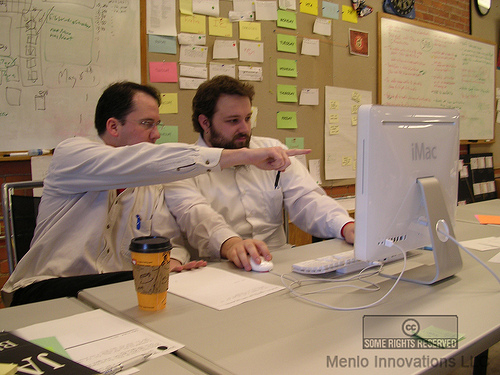As an SVPM Scrum Team member, I joined the group PBI (Product Backlog Item) to install, design, and develop a Learning Management System (LMS) plug-in for WordPress, during Sprint 8. The team decided to add another layer to the LMS PBI, by encouraging members to try out pair programming. My initial thought was, “Isn’t this just for engineers writing code?” However, with an open and inquisitive mind, we took on pair programming to test our hypothesis and address the topic brought up during our retrospective, which was to find different methods to encourage team collaboration.
And so, we proceeded with our pair programming user story, to enhance collaboration during our Sprint 8 LMS PBI. Pair programming typically calls for two software engineers working on the same code as a pair, to reduce mistakes. One engineer will drive, while the other observes. As a scrum team, we quickly self-organized during the sprint, to start adjusting pair programming to how our volunteer team functioned. Our first task for the LMS PBI, was to receive instruction from our Agile Coach, David Bakhtnia, who did an amazing job of walking us through the necessary steps of preparing the testing stage, installing the LMS WordPress plug-in, and then leaving it to us to develop the course content. As we divided into pairs, our task was to duplicate the steps our Agile Coach provided, and then begin to develop the LMS course content as a pair. I paired up with Jay Rajpara, and in the spirit of remote pair programming, Jay drove, I observed, and we both guided each other along the way. What I began to notice after our first zoom session was that since we were both new at installing the LMS plug-in, and taking on the task to uncover how to develop the course content, we were able to fill in gaps in our knowledge, and encourage each other to explore different approaches when we came across a question. By filling knowledge gaps, we were able to use our collaboration to also speed up our learning pace.
Our pair programming experiment delivered more than anticipated. To my surprise, we were able to implement pair programming remotely, to encourage each other’s exploration, growth, and collaboration. In the prior sprint, PBIs were assigned to individuals, instead of teams or pairs. During Sprint 8, we worked in teams, and in pairs, which helped spike our collaboration. We were able to learn from each other and make more progress on the LMS PBI. We also made adjustments that worked for our teams, while keeping the spirit of pair programming intact. Implementing pair programming outside of the software engineering roles was a success for us, and I would encourage others to try this approach.


Thank you for your neat post, Espy. Your tidy note of paring to accomplish the tasks, from diving into user stories to collaboratively communicating, dividing the tasks, and sharing your findings of the sprint backlog item (SBI) is greatly appreciated. This is a nice paired approach to exploring unknowns when accomplishing tasks.
I encourage readers to contact us and engage with us for hands-on and practical experience to learn Agile and Scrum.